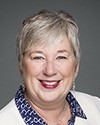Thank you for the question.
It continues to be both of those things. What I would say—and I think I said this at the time, as well—is what's most exciting about it is that it's truly galvanized the department and the stakeholders, and even the fishing industry and others, to say, “Okay, this is going to happen. How are we going to make it happen? What sorts of things are we going to do?”
I would say two things. It's quite different for 2017, which is the 5%, and 2020, which is the 10%. We are now going through an exercise of identifying the sensitive areas that we have already identified through science. Those are corals and sponges. These are key rearing areas and spawning areas, and we're looking at areas that need protection. We are also looking at what the best tools are for those protections, understanding that creating formal MPAs, marine protected areas through regulations takes time. We're going to have to use other measures for the protection, and that's the exercise we've been going through this fall.
We've also been talking to the fishing industry, the oil and gas industry, the shipping industry, and others to make sure they're part of the discussion. We've been engaging with environmental groups and academics, who have a lot of this information. That's been the exercise. It's also about trying to figure out what the criteria are that we need to say that we've done this, and to be able to say that this counts as x per cent.
In addition, there have been a number of specific closures. There was a significant canyon closure off of Nova Scotia, which was announced, I think it was in early September. There was Darnley Bay in the north, which was announced very recently. There have been others.
The other thing I would say is that it's not just DFO, even in the federal government. Parks Canada does national marine conservation areas, and they are working on Lancaster Sound, which would get 2%. That's a major one up in the Northwest Passage. Environment Canada does national wildlife areas, and they're working on Scott Island, which is at the north end of Vancouver Island.
We have structure and organization within the government. We're working with environmental groups, and with industry. We're trying to figure out how we get to that 5% and how we get the more formal MPAs in place by 2020.




